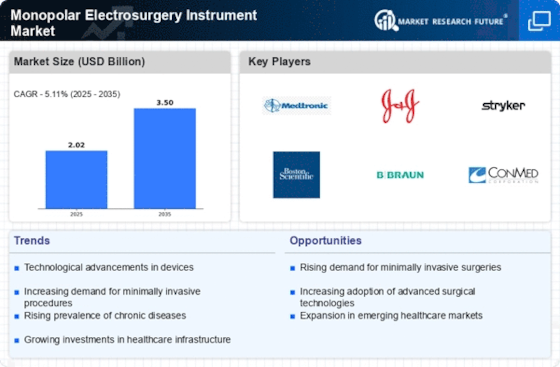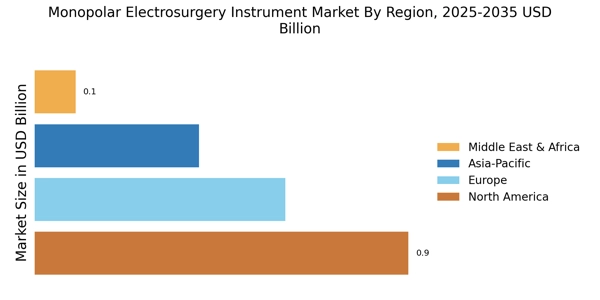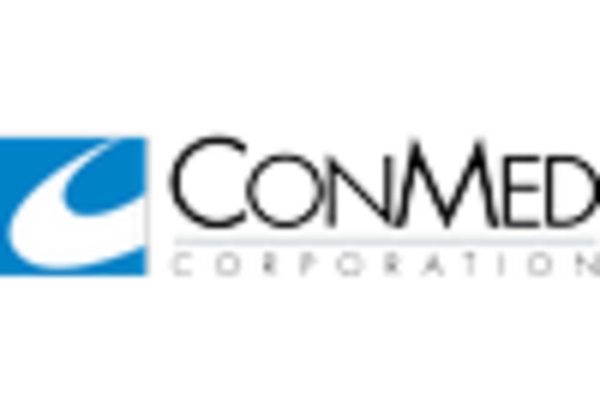Growth in Surgical Procedures
The Monopolar Electrosurgery Instrument Market is poised for growth due to the increasing number of surgical procedures performed worldwide. Factors such as an aging population, rising prevalence of chronic diseases, and advancements in surgical techniques contribute to this trend. It is estimated that the number of surgical procedures is expected to reach over 300 million annually by 2026, creating a substantial demand for monopolar electrosurgery instruments. This growth is particularly evident in specialties such as gynecology, urology, and general surgery, where monopolar instruments are frequently utilized. As healthcare systems adapt to meet this rising demand, the market for these instruments is likely to expand significantly.
Expansion of Healthcare Infrastructure
The Monopolar Electrosurgery Instrument Market is also being driven by the expansion of healthcare infrastructure in various regions. As countries invest in improving their healthcare systems, the availability of advanced surgical technologies, including monopolar electrosurgery instruments, is increasing. This expansion is particularly notable in emerging markets, where healthcare facilities are being upgraded to meet the growing demand for surgical services. The establishment of new hospitals and surgical centers is likely to create additional opportunities for the adoption of monopolar instruments. Furthermore, government initiatives aimed at improving healthcare access and quality are expected to bolster the market, making these instruments more widely available to surgeons and patients alike.
Technological Advancements in Electrosurgery
The Monopolar Electrosurgery Instrument Market is experiencing a surge in technological advancements that enhance surgical precision and efficiency. Innovations such as improved electrode designs and advanced energy delivery systems are being integrated into monopolar instruments. These advancements not only facilitate better tissue cutting and coagulation but also reduce the risk of thermal injury to surrounding tissues. The market is projected to grow at a compound annual growth rate of approximately 6.5% over the next five years, driven by these technological improvements. Furthermore, the introduction of smart electrosurgical devices that offer real-time feedback and monitoring capabilities is likely to revolutionize surgical practices, making procedures safer and more effective.
Rising Awareness and Adoption of Electrosurgery
The Monopolar Electrosurgery Instrument Market is benefiting from increased awareness and adoption of electrosurgical techniques among healthcare professionals. Educational initiatives and training programs are being implemented to familiarize surgeons with the advantages of monopolar electrosurgery, including its efficiency and effectiveness. As more surgeons become proficient in using these instruments, the market is likely to see a corresponding increase in demand. Additionally, the growing body of clinical evidence supporting the safety and efficacy of monopolar electrosurgery is further encouraging its adoption. This trend is expected to drive market growth as healthcare facilities invest in advanced electrosurgical equipment to enhance their surgical capabilities.
Increasing Preference for Minimally Invasive Procedures
The Monopolar Electrosurgery Instrument Market is significantly influenced by the rising preference for minimally invasive surgical procedures. These techniques are associated with reduced patient recovery times, lower risk of complications, and minimal scarring. As healthcare providers and patients alike seek to optimize surgical outcomes, the demand for monopolar electrosurgery instruments is expected to rise. According to recent estimates, minimally invasive surgeries account for over 50% of all surgical procedures performed, indicating a robust market potential for monopolar instruments. This trend is likely to continue as advancements in technology further enhance the capabilities of these instruments, making them indispensable in modern surgical practices.


















Leave a Comment